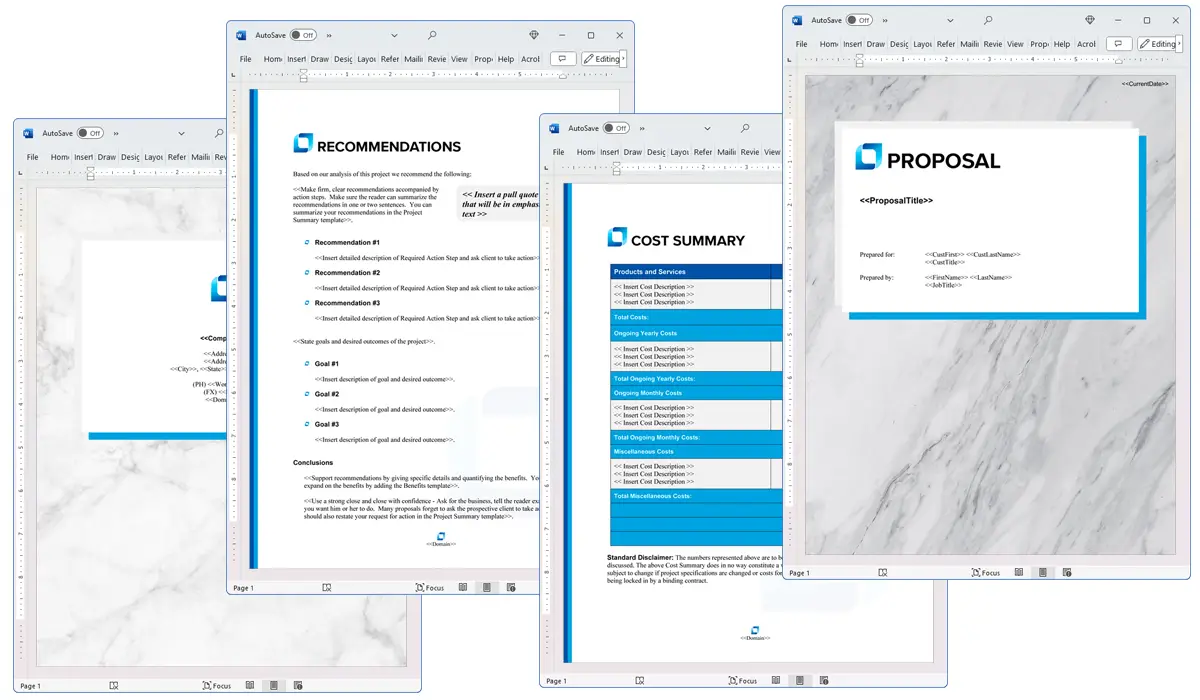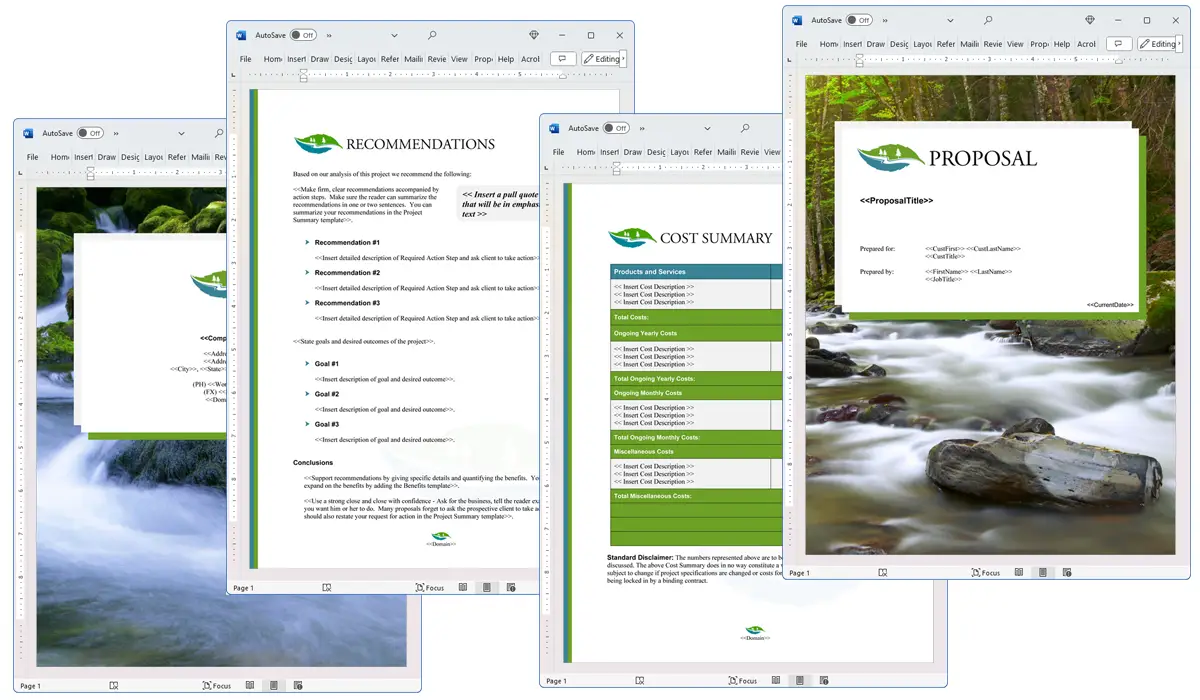What is the RFP Policies chapter used for?
Proposal Kit Professional Bundle adds more design themes, all six Contract Packs,
a project management library, and Expert Edition software.

Illustration of Proposal Pack Classic #19
We include this RFP Policies chapter template in every Proposal Pack, along with thousands more. You assemble this chapter with others in various combinations to create custom-tailored business proposals, plans, reports, and other documents. Proposal Packs apply custom visual designs to the templates, giving the final documents a consistent professional finish.
 DOWNLOADABLE, ONE-TIME COST, NO SUBSCRIPTION FEES
DOWNLOADABLE, ONE-TIME COST, NO SUBSCRIPTION FEES
Overview of the RFP Policies Chapter
When creating a proposal in response to a Request for Proposal (RFP), it is crucial to articulate the policies that govern the interaction between the proposer and the issuing organization. The 'RFP Policies' chapter is designed specifically for this purpose within the Proposal Kit system. This chapter serves as a dedicated space where a company can outline the rules and guidelines that respondents must follow when participating in the RFP process. Implementing this chapter helps ensure that all parties are aware of the protocols, promoting a transparent and fair bidding environment.
How is the RFP Policies Chapter Used?
When used in a business proposal, the RFP Policies chapter is used to set the stage for how the RFP process will be managed. It is typically positioned in the early sections of a proposal document to establish the ground rules before delving into the specifics of the proposal itself. By clearly stating the policies upfront, companies can mitigate misunderstandings and manage expectations with potential contractors or service providers. This chapter acts as a reference point that respondents can revisit throughout the proposal preparation phase to ensure compliance with the stipulated rules.
What is Included in the RFP Policies Chapter?
The contents of the RFP Policies chapter can vary depending on the organization's requirements and the nature of the RFP. However, common elements often included are:
- Handling of Responses: Guidelines on how proposals should be submitted, processed, and evaluated.
- Integrity Measures: Policies addressing actions in cases where a respondent attempts to circumvent the process or engage in dishonest activities.
- Communication Protocols: Definitions of approved methods of communication between the company and respondents during the RFP process.
- Confidentiality Agreements: Rules to protect sensitive information shared during the proposal process.
- Conflict of Interest Statements: Requirements for disclosing potential conflicts of interest by respondents.
Use Case Examples for the RFP Policies Chapter
- Government Contracts: Ensuring all respondents adhere to strict federal regulations regarding procurement and data handling.
- Technology Tenders: Outlining specific security protocols that respondents must follow when proposing IT solutions.
- Construction Projects: Detailing safety and compliance policies that contracting firms must accept and implement.
- Healthcare Services: Enumerating privacy policies in line with HIPAA regulations for companies proposing healthcare solutions.
- Educational Proposals: Setting guidelines for engagement with educational institutions, including adherence to ethical standards and confidentiality norms.
Key Takeaways
- The RFP Policies chapter is important for setting the ground rules in a proposal response to an RFP.
- It ensures all respondents are aware of and adhere to the company's operational and ethical standards.
- The chapter typically includes policies on response handling, integrity, communication, confidentiality, and conflict of interest.
- Proper use of the RFP Policies chapter can prevent misunderstandings and promote a fair competitive environment.
- This chapter is and can be tailored to fit the specific needs of various industries and RFP types.

Illustration of Proposal Pack Real Estate #5
 What Our Clients Say
What Our Clients SayI have used this product for years and the speed with which I am able to send out proposals is staggering due to this tool. I wholeheartedly recommend it to anyone."
Alpha Nerd and Associates
 4.7 stars, based on 845 reviews
4.7 stars, based on 845 reviewsAlternate Chapters
Related Chapters
Samples Using the RFP Policies Chapter
Document Layouts Using the RFP Policies Chapter

The RFP Policies chapter and other chapters are integrated into a Word document as illustrated here in the Proposal Pack Aqua #7 design theme. There are hundreds of design themes available, and every design theme includes the RFP Policies chapter template.
A proper business proposal will include multiple chapters. This chapter is just one of many you can build into your proposal. We include the complete fill-in-the-blank template in our Proposal Pack template collections. We also include a library of sample proposals illustrating how companies in different industries, both large and small, have written proposals using our Proposal Packs. This template will show you how to write the RFP Policies.
We include a chapter library for you to build from based on your needs. All proposals are different and have different needs and goals. Pick the chapters from our collection and organize them as needed for your proposal.
Using the Proposal Pack template library, you can create any business proposal, report, study, plan, or document.
 Ian Lauder has been helping businesses write their proposals and contracts for two decades. Ian is the owner and founder of Proposal Kit, one of the original sources of business proposal and contract software products started in 1997.
Ian Lauder has been helping businesses write their proposals and contracts for two decades. Ian is the owner and founder of Proposal Kit, one of the original sources of business proposal and contract software products started in 1997.By Ian Lauder
 Published by Proposal Kit, Inc.
Published by Proposal Kit, Inc.


 Cart
Cart
 Facebook
Facebook YouTube
YouTube X
X Search Site
Search Site